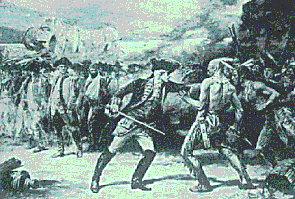
From Original Painting Courtesy Glens Falls Insurance Co.
THE FRENCH and INDIAN WAR 1754-1763 was the last and most important conflict over French and British possessions in North America. Unlike the three earlier wars, which began in Europe and then spread to America, this struggle broke out first in America. Territorial rivalries had become more intense as British and French settlements expanded over the years. Disputes arose over the Great Lakes Region and the land around Lake George and Lake Champlain.

From Original Painting Courtesy Glens Falls Insurance Co.
Fort William Henry was constructed by the British during the armed prelude to the final colonial conflict between France and England in the New World. The fort was a key British installation in the northern defense of the colony of New York as well as a launching point for future military operations against the threatening French Empire to the north.
In August of 1757, the most brilliant French general of the colonial period, the Marquis de Montcalm, sailed up Lake George with a force of 8,000 crack French regulars, a large party of Indian allies, Canadian volunteers, and an artillery train of thirty-two pieces.
Once their cannons were in siege position, the French expected the fort to surrender rather than engage such an impressive army in the battle. When an easy capitulation was not forthcoming, Montcalm initiated a brutal assault. After a seige of six days, the British, under Monroe, realized that the structure of the fort was near collapse and holding out any longer would be impossible. Yet by withstanding the French onslaught for such an extended period, the British had time to mass troops further south. After Monroe surrendered, Montcalm recognized that any attempts to continue his expedition further south would be futile. The terms of capitulation included a promise of safe passage for the beleaguered English who were able to make the trip to Fort Edward. This greatly mystified and angered the Indians who had accompanied Montcalm from Canada for the sole purpose of securing English scalps. Montcalm, underestimating the ferocity of his Indian allies, had detailed but a small guard of French regulars to escort the garrison to Fort Edward. As the pitiful column of unarmed survivors marched down the military road, the Indians could be restrained no longer. Although the precise number of Englishmen killed during the massacre may never be ascertained, historians agree that it constituted one of the bloodiest pages of colonial American History. Following the massacre, Montcalm razed the fort, covered the charred remains with sand and returned to Canada.